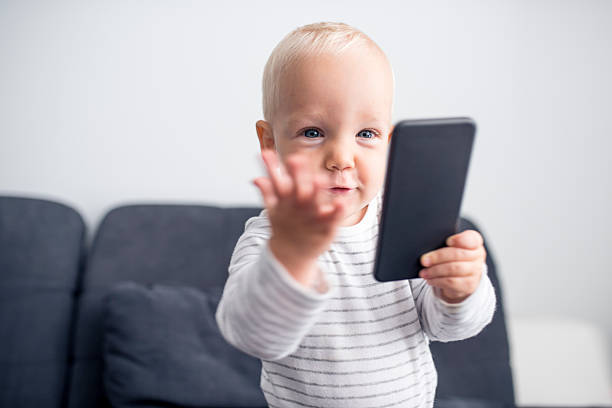Currently, it is estimated that over 65% of the world (or 5 billion people) have access to the internet (Shewale, 2024). In such a connected world, it may seem overwhelming for parents to figure out how they want their child to spend their time, and how to support their learning. With new apps, videos, and even online reading books, you may wonder– what exactly does technology do for language development? While psychologists and linguists are actively seeking answers to this question, it’s already clear that many misconceptions exist surrounding technology’s role in early learning. The following are common questions about technology and its impact on children’s language development.

1. Does technology hinder language development?
Many parents worry that technology might harm their child’s language development. Viewpoints on this question vary. Some studies have shown that technology may have negative associations with some aspects of language learning. For example, the consumption of television content has been found to be negatively associated with vocabulary and grammar development in 2 year old children (Sundqvist et al, 2021). Similarly, in infants aged 8 to 16 months, digital media promoting early language and cognitive development has also been found to have a negative association with vocabulary development (Zimmerman et al, 2007).
However, results do not all point towards a negative impact. Some digital technology has been found to be useful in promoting language and literacy skills in children (Liu et al, 2024). In one study by Korat et al(2013), 3-4 year olds that read ebooks independently and children whose parents read out loud to them showed higher phonological and comprehension awareness than children that received no reading interventions. This study showed that there could be potential benefits to online digital media, especially for older infants or children (Korat et al, 2013). So in short: the jury’s out, and ‘technology = bad for language development’ is way too simple to be true.
2. Will an infant become bilingual if they watch videos in another language?
Not quite. With language learning, an important aspect is social interaction, where an infant is actively engaging with a person using the language. In one study, researchers showed English monolingual 9-10 month olds videos in Mandarin Chinese. They found infants were able to tell apart the sounds of Mandarin better when they heard it from a live person than from a recording, which suggests that language learning of this type requires more than just auditory information (Kuhl et al, 2003). A live person provides social cues, a shared environment, and shared attention, which a video cannot provide (Kuhl et al, 2003). With any type of video playing in the background, infants are more likely to passively listen to it than to continuously engage with what is occurring. As a result, infants in the study that simply watched or listened to foreign language media did not learn the Chinese phonemes (speech sounds). Simple exposure to media is not enough to learn a new language (Kuhl et al, 2003).
3. Should infants not be exposed to technology at all then?
In a world as connected as ours, it seems impossible to fully disconnect. Technology and its role in language development is not fully understood, but there are potential benefits. Overall, the best advice is to expose young infants to technology in moderation, and as a supplement to parent-child interactions (Operto et al, 2020), in a way that works for your family. Young infants are fascinated and fascinating new learners; technology can serve as a powerful tool to further help their language development, when used appropriately, and not as a substitute for human-to-human interaction.
References
Korat, O., Shamir, A., & Heibal, S. (2013). Expanding the boundaries of shared book reading: E-books and printed books in parent–child reading as support for children’s language. First language, 33(5), 504-523.
Kuhl, P. K., Tsao, F.-M., & Liu, H.-M. (2003). Foreign-Language Experience in Infancy: Effects of Short-Term Exposure and Social Interaction on Phonetic Learning. Proceedings of the National Academy of Sciences – PNAS, 100(15), 9096–9101. https://doi.org/10.1073/pnas.1532872100
Liu, S., Reynolds, B. L., Thomas, N., & Soyoof, A. (2024). The Use of Digital Technologies to Develop Young Children’s Language and Literacy Skills: A Systematic Review. Sage Open, 14(1). https://doi-org.ezp-prod1.hul.harvard.edu/10.1177/21582440241230850
Operto, F. F., Pastorino, G. M. G., Marciano, J., de Simone, V., Volini, A. P., Olivieri, M., Buonaiuto, R., Vetri, L., Viggiano, A., & Coppola, G. (2020). Digital Devices Use and Language Skills in Children between 8 and 36 Months. Brain Sciences, 10(9), 656. https://doi.org/10.3390/brainsci10090656
Shewale, R. (2024, January 19). Internet user statistics in 2024 – (Global Demographics). DemandSage. https://www.demandsage.com/internet-user-statistics/
Sundqvist, A., Koch, F. S., Birberg Thornberg, U., Barr, R., & Heimann, M. (2021). Growing up in a digital world–digital media and the association with the child’s language development at two years of age. Frontiers in Psychology, 12, 569920.
Zimmerman, Frederick J., PhD, Christakis, Dimitri A., MD, MPH, & Meltzoff, Andrew N., PhD. (2007). Associations between Media Viewing and Language Development in Children Under Age 2 Years. The Journal of Pediatrics, 151(4), 364–368. https://doi.org/10.1016/j.jpeds.2007.04.071

Stephanie Zaragoza
Author
Stephanie is currently a junior psychology student at Harvard. She is interested in clinical psychology, but also in developmental psych and learning disorders. In her free time, she enjoys showing pictures of her dog Coco and listening to music.
Elika Bergelson
Principal Investigator
